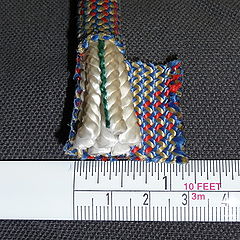- Dynamic rope
-
A dynamic rope is a specially constructed, stretchable rope. This 'stretch' is what makes it 'dynamic', in contrast to a static rope that doesn't have any give when under load. By stretching under load, a dynamic rope will soften the impact of extreme stresses on it, such as falls, and lessens the likelihood of failure. This is particularly useful in rock climbing, where it can absorb much of the energy of a fall (referred to as a whipper amongst rock climbers). Kernmantle ropes (with a jacketed core) are the most common type of dynamic rope, and nylon has replaced all natural materials since 1945 for durability and strength.
Dynamic ropes used for rock climbing come in a variety of lengths and diameters, with the most common lengths being 50, 55, and 60 meters (approximately 165, 185, and 200 feet, respectively). Lengths will vary depending on rope maintenance and age, and there are even ropes as long as 70 meters for specialized ascents on routes that would normally require a multi-pitch climbing attempt due to being only slightly longer than a standard rope length.
Rope diameters are generally between 8.3mm and 11.5mm, with the different diameters used for slightly different purposes. Sport and multi-pitch climbers value thinner ropes because they are lighter, lessening rope drag and making clipping to the quickdraw easier and, consequently, safer. Lighter, thinner ropes, however, have less strength than a thicker rope and will absorb fewer hard falls. Note that some belay devices are better suited for different rope diameters. This is particularly relevant with auto-belay devices, such as the Petzl Grigri (which, for example, works best with a 10mm thick line) or the Faders SUM. Please make sure to read the instructions for your device carefully to ensure safety and recognize any limitations to rope diameter.
All modern rock climbing dynamic ropes are rated for the number of hard falls they can absorb safely before being retired. Thicker ropes generally have a higher rating (will absorb more falls) than a thinner diameter rope. The quality and construction of the rope will also determine the number of falls. Some climbers may find it desirable to receive a 'soft catch' during a hard fall and opt to use a stretchier, more dynamic rope, despite the possibility that such a rope will have a lower overall rating.
Rope care and maintenance
Modern ropes are made from nylon and don't require a great deal of maintenance. Ropes should however be inspected for cuts, abrasions, or frayed areas; any cut or fraying that passes into the core of the rope is cause for concern. Ropes can also be washed to clean them of any extensive dirt or grime.
See also
References
- Notes
- Sources
Categories:- Caving equipment
- Climbing equipment
- Mountaineering equipment
Wikimedia Foundation. 2010.

